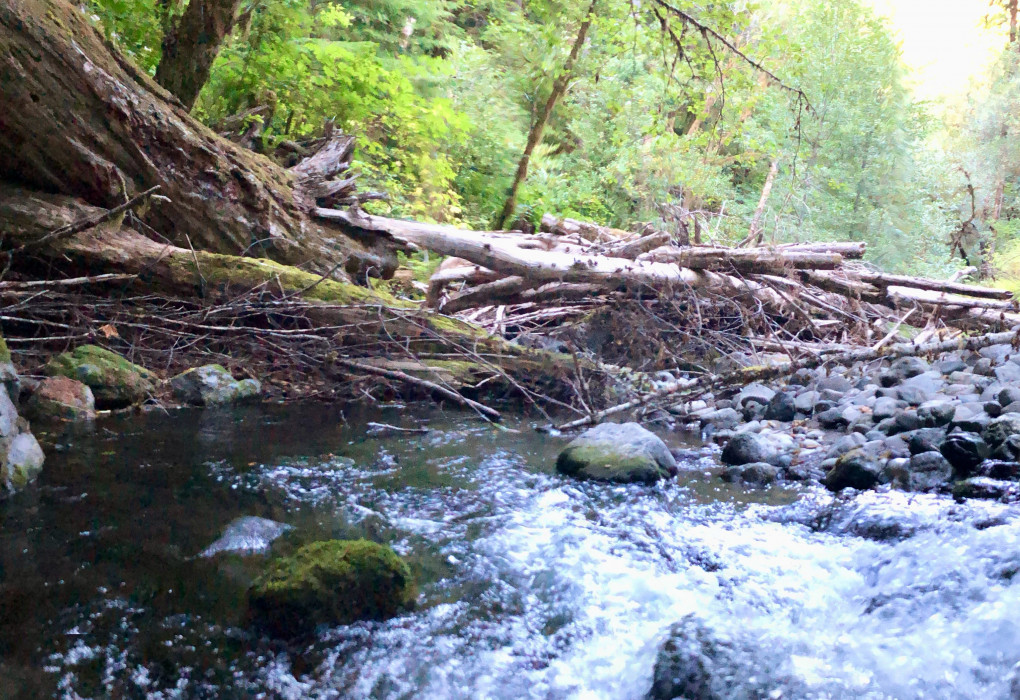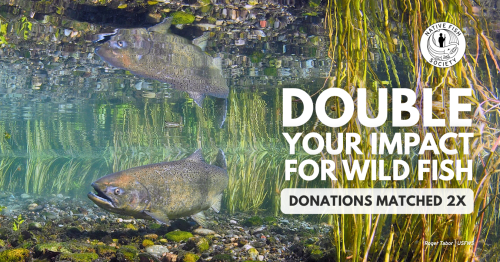Oregon's Southern Coast - A Stronghold for Wild Anadromous Fish
In mid august, I visited watersheds located on Oregon’s southern coast to learn more about the communities, fish, and the environment. I had a simple goal - learn what I can do to support these watersheds to thrive.
I started my journey on the Elk River located south of Bandon, Oregon about four miles north of Port Orford. A local advocate and conservationist met me to provide a first hand tour of the beauty, strengths, and weaknesses of the watershed so close to this rural community.
Our first stop was located on the lower end of the Elk River on some private land that hosted areas of cold water refugia for coho during the late summer months. This ranch is a working sheep ranch that demonstrates environmental stewardship while running a successful business operation. The habitat was immense based solely on a working lands conservation effort by landowners to protect the area from overgrazing or other damage related to agriculture. I immediately pictured the small side channels I snorkeled a week prior with abundant populations of juvenile Coho. What a forward-thinking conservation tactic to protect these endangered fish for many years to come. It displayed how critical it is for private and public land managers to work together in order to restore and protect these places and species.
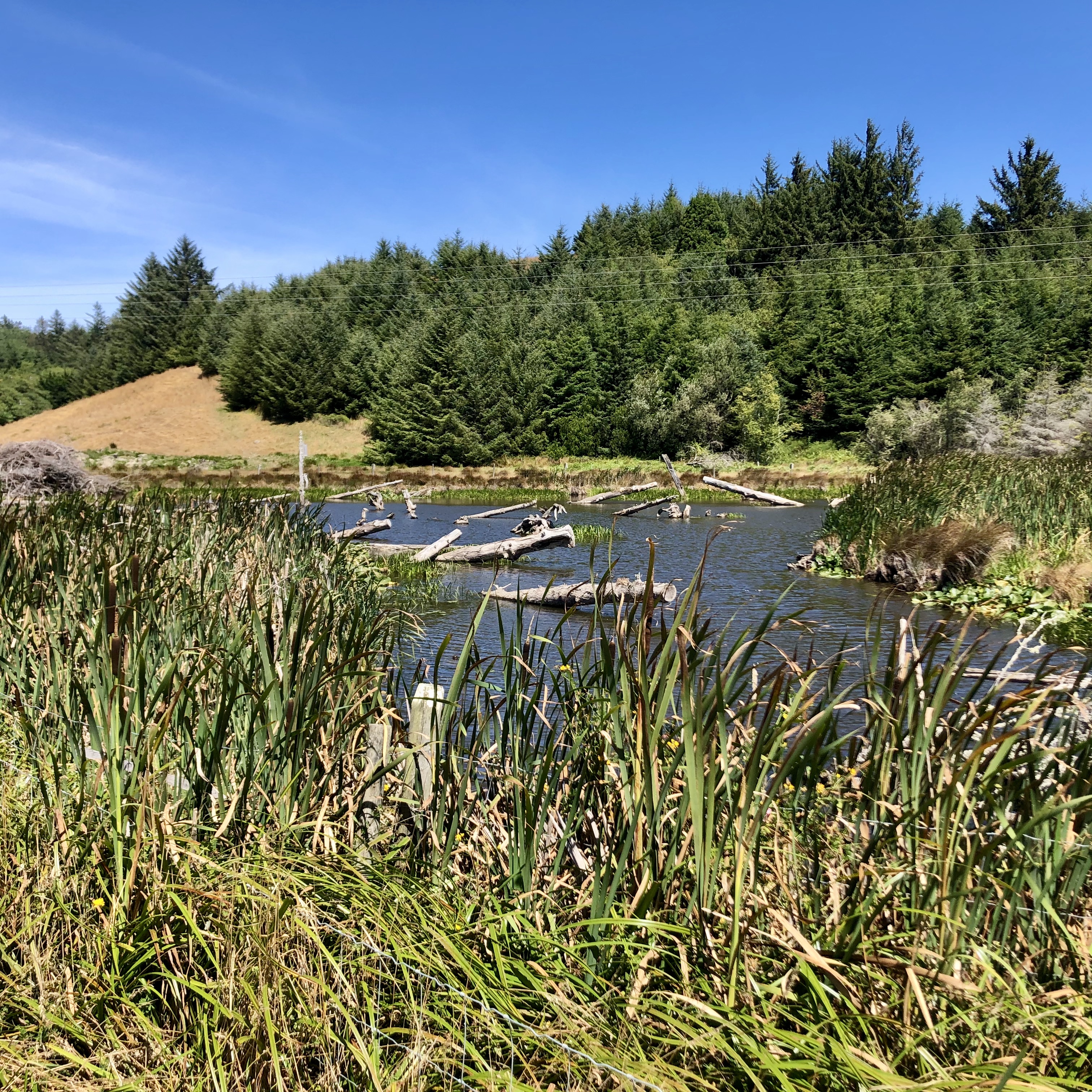
Cold water refugia located near the lower Elk River.
Researching prior to my visit, I found a documentary on the Elk River of Jim Rodgers, a conservationist, logger, and advocate who worked tirelessly to protect the Elk River old growth timber from being removed in the 1970s. His passion and advocacy, along with the support of many others, established two beautiful wilderness areas in the upper Elk River basin, Grassy Knob Wilderness Area, and Copper Salmon Wilderness Area. His home sits across the Elk River on Anvil Creek near the Grassy Knob Wilderness Area boundary. When you have a few minutes, watch Oregon Public Broadcasting Network’s well done film on Jim’s story.
We traveled up river discussing the challenges the watershed faces and looking at the undisturbed habitat of Elk River. The road took many turns past the amazing landscape of deep canyon walls and densely packed old growth timber. The road led to Bald Mountain Creek, the angling deadline for salmon and steelhead fishing in the fall and winter. After a couple mile drive, my host and I parked and exited our vehicles for a short hike across the low flows of the Elk River. We ventured up a small creek into an old growth stand with trees well over 50” in diameter. We finished the evening by discussing the limiting factors to the fishery and the wild fish that utilize the Elk River. There’s one clear thing about the Elk River, the habitat is astonishing and protected from logging or degradation for many years. ODFW indicated two major priorities in the Coastal Multi-species Conservation and Management Plan, one of those priorities is the Elk River Fall Chinook, clearly highlighting hatchery fish as being a significant factor for the future of wild Fall Chinook.
I spent the evening exploring the upper reaches of the watershed, including the North Fork of the Elk River and Panther Creek, two streams that are known strongholds for spawning wild Fall Chinook Salmon. I took a mile hike up Panther creek noticing all the downed timber and pools creating refuge for fish to hold and spawn in during high water. Enjoying my time in this area I stayed the night camping at the confluence of Panther Creek and Elk River.
While camping that evening, I started reading research shared with me about Elk River Fall Chinook and pondering a key question: What is limiting these fish from thriving in abundant numbers? The Oregon Department of Fish and Wildlife recently released a Population Viability Analysis for the species to determine their health and longevity. The document linked above displayed very concerning results and questions.
It clearly shows, as the most likely scenario, that there is a 89% chance wild Fall Chinook of the Elk River will go extinct in the next 100 years. These fish have received high pressures of hatchery fish mixing with wild fish on the spawning grounds. This also poses a genetic risk, mixing wild resilient genes with hatchery genes that don’t host near the adaptability that wild fish contain. This pressure, coupled with failed spawning attempts, has decimated historical runs of wild Fall Chinook in Elk River. This created even more questions: What can be done to fix this problem? How can we work to create more opportunity for wild fish? Will we as humans, in the 21st century, cause extinction of these beloved wild fish?
I awoke the next morning to the beauty of glistening sunshine through the coniferous forest of the Elk River watershed. I planned to head down river and visit the Elk River Hatchery to understand the process of producing and rearing the fish that ODFW provides for additional harvest opportunity. This opportunity includes fish for the Pacific Salmon Treaty (PST). The Elk River Fall Chinook have been selected by the Oregon Department of Fish and Wildlife as an escapement indicator stock for the PST helping commercial fishery managers understand where and how many fish from each area/watershed they are harvesting in the ocean. This includes commercial fishermen from along the coast of North America; Alaska, British Columbia, Washington and Oregon. Oregon Department of Fish and Wildlife embeds a coded wire tag in 255,00 hatchery fish to track and determine where the Fall Chinook from Elk River, and other areas throughout North America, are being harvested.
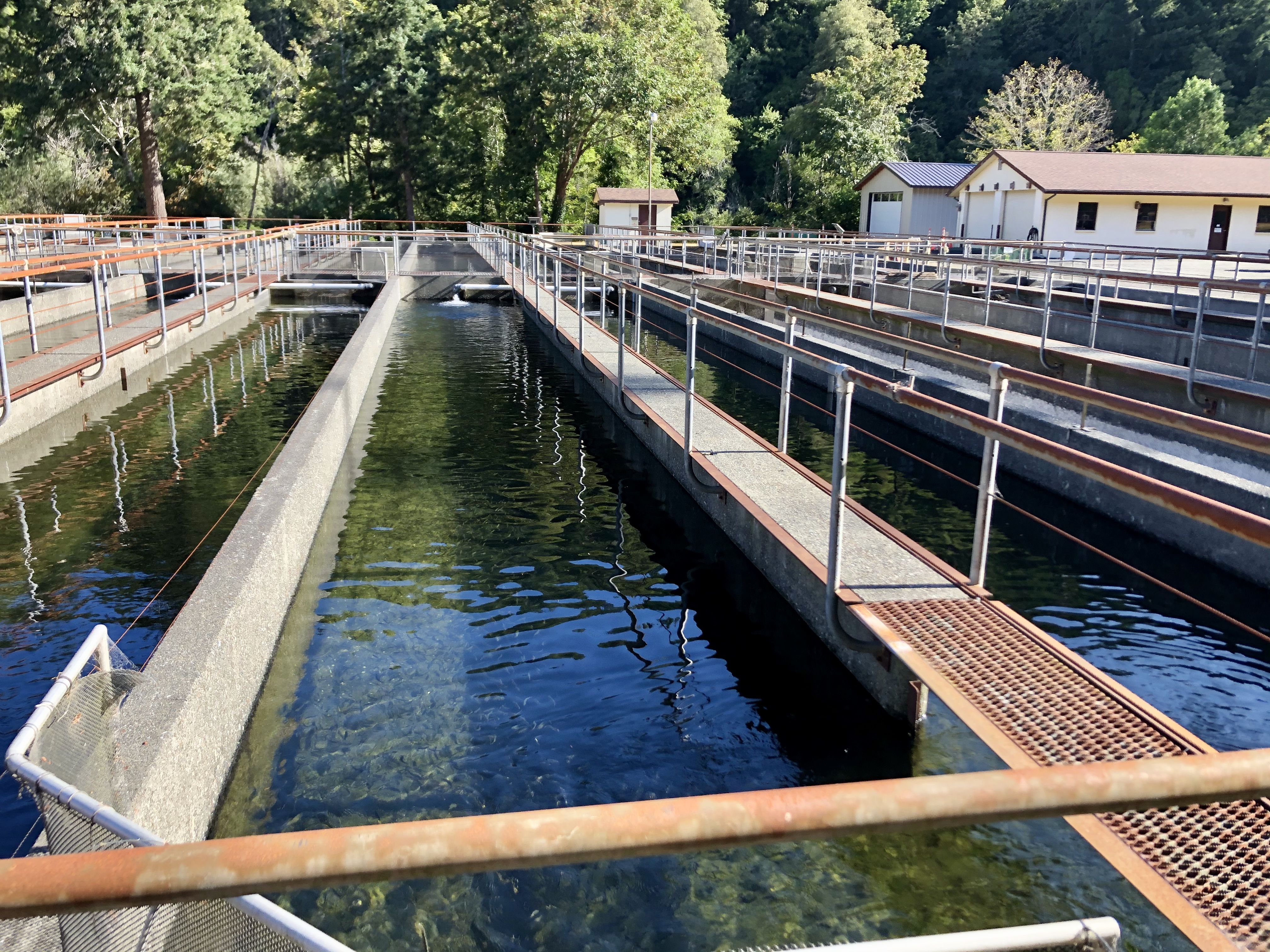
Ponds located at Elk River Hatchery
I met with the manager at the hatchery where he graciously gave me a socially distanced tour due to COVID 19. He has quite the operation where he spawns and rears Fall Chinook, Winter Steelhead, and some trophy Rainbow Trout for local lakes. The hatchery fish are released in the Elk River and Chetco River to supplement the fishery for anglers.
The 255,000 Fall Chinook released on the Elk River incorporate the majority of the ponds at the hatchery. In the past ten years, there have been high rates of hatchery fish spawning in the river, they call this percent hatchery origin spawners (pHOS). This poses a threat to the wild fish and is something against best practice. In recent years, pHOS for Fall Chinook has been recorded at 80% or in other words, 80% of the fish in the Elk River on spawning beds were of hatchery fish origin. Oregon Department of Fish and Wildlife’s Native Fish Conservation Policy recommends a rate no higher than 10%. Due to these high numbers, ODFW has been working on techniques to ensure all hatchery fish return to the fish hatchery instead of spawning in the wild. These actions have added no success in reviving abundant wild fish, merely decreasing the number of hatchery fish found on the spawning beds.
My visit ended well in the Elk River basin as I met new friends and was brought up to speed on the issues the river and its fish currently face. This will be the first year in known history that ODFW is requiring catch and release for wild Fall Chinook on the Elk River. This management decision is ironic - these hatchery releases are based solely on the rationale to create more opportunity for angler/commercial harvest. I look forward to working with agencies and the community to restore a healthier fishery for all to enjoy and the betterment of these fish.
I traveled down Highway 101 to Gold Beach, where I met with the local fisheries biologist for the South Coast. It was great meeting him in person as I had spent countless hours on phone calls listening to the planning and future management of the Rogue and South Coast Fisheries over the past six months. During this process, Native Fish Society, other conservation groups, and stakeholders have given input on how the fisheries, including Winter/Summer Steelhead, Coho recovery, and Cutthroat Trout can best be managed for success. We discussed the Rogue South Coast planning process, the difficulties of consensus with all groups and the overarching goals we are all trying to achieve - wild abundant fish for everyone to enjoy.
That evening, I traveled south to Hunter Creek, one of the smaller streams that travels directly into the Pacific Ocean. I met with our local River Steward, Dave Lacey and Native Fish Society Executive Director Mark Sherwood for an evening happy hour on a stream they both love, Hunter Creek. Mark started by showing me a parcel of land near the estuary of Hunter Creek that is available for sale. He shared that local conservation groups, including Native Fish Society, were working to support the local land trust to buy and protect that land from future development.
We headed up Hunter Creek to a small gravel bar where the three of us could catch up and talk about the threats to Hunter Creek. It was my first time meeting Dave in person due to COVID 19 and it was a pleasure. He owns and operates South Coast Tours, and devotes numerous hours of free time to conservation work in the nearby watersheds and forests. Dave was pivotal to building local support for a 20-year mineral withdrawal that restricted strip mining on public lands and passed back in 2017. He continues to assist with conservation campaigns along the South Coast.
What a great evening with new friends and wonderful mentors in conservation. We shared stories and I listened to the challenges the watershed faces from logging and other limiting factors. I ended the evening by driving to the top of the watershed where I found Hunter Creek Bog, a beautiful wetland surrounded by serpentine soils, and native flora and fauna. I camped that evening on the edge of the forest reminiscing on the great day I just experienced.
I awoke early the next morning in anticipation of traveling to Huntley Park on the Rogue River to assist ODFW’s seining crew with one of their weekly seine surveys. The Huntley Park Seining is a critical component of long-term monitoring that has occurred since the 1970s. This data set provides information that assists in population health, genetics, run timing, and much more.This was definitely a great experience for me to educate myself on how ODFW measures fish populations in the Rogue Basin.
The crew starts with a large seine net on the front of their open top sled boat. They maneuver around to link the net to a large piece of bedrock. After that, they extend the net across the river where they circle around to the far side of the Rogue and bring the net completely back to the starting location. Each person has their own task and responsibility to ensure every netting goes smoothly. This is completed 15 times before the morning is over regardless of how many fish are caught.
It's a gamble to see what comes with each seine. One time the crew will net 20 half pounders (A half-pounder is an immature steelhead that returns to freshwater within about four months of entering the ocean), a few adult Summer Steelhead and a single Fall Chinook. Next, the crew could be skunked. Every fish is measured, documented and released back to the wild to find its way up the Rogue River.
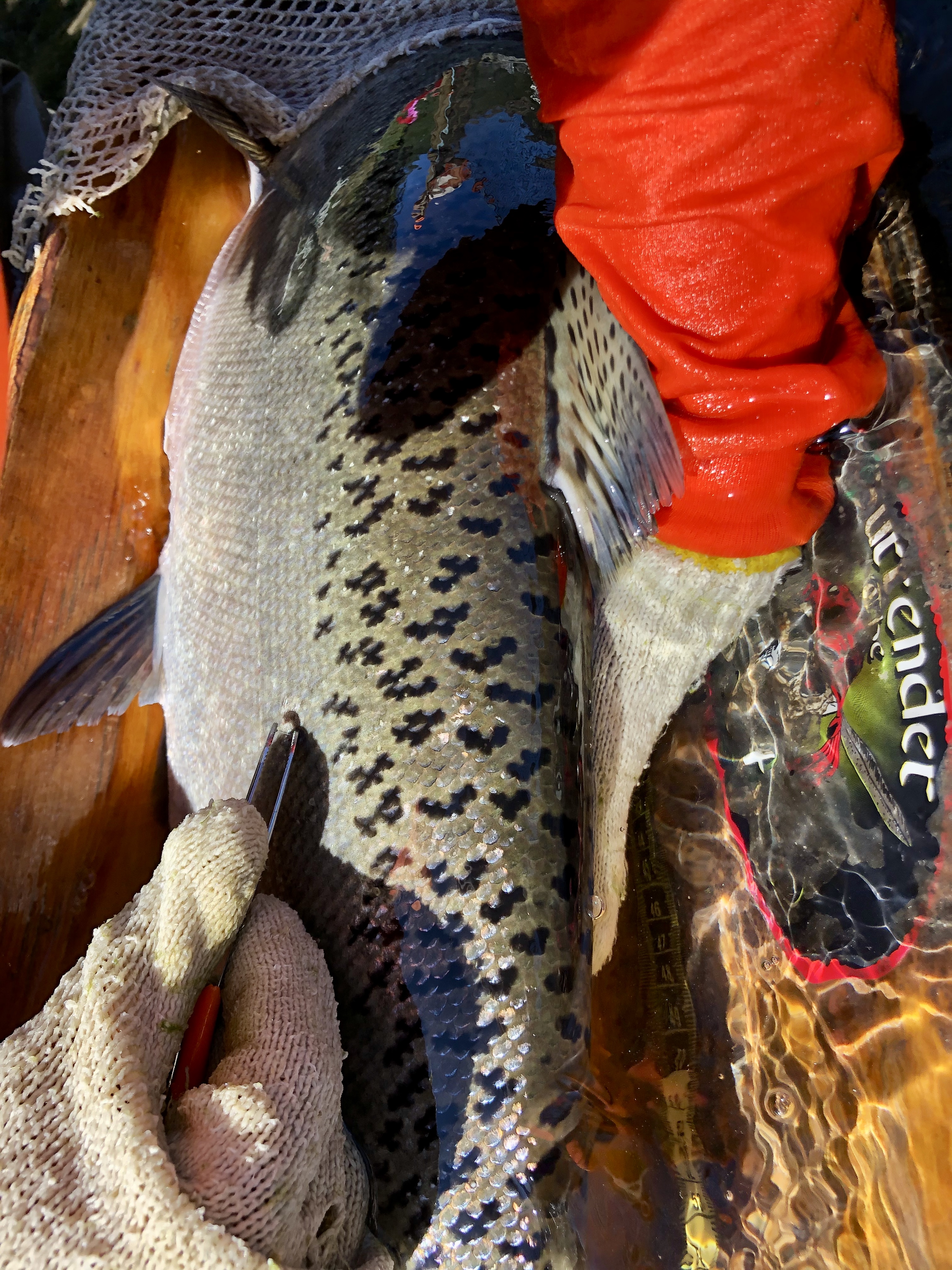
Huntley Park seine crew member removes a scale sample from an adult Fall Chinook.
What a great opportunity to understand the hard work that ODFW’s crew undergo to ensure they have proper data to monitor the fish of the Rogue Basin. The seining crew was great to work with. Everyone provided a positive team effort to accomplish the task. It was a pleasure to assist and help where needed.
Shortly after, I headed south to meet up with Native Fish Society’s Executive Director Mark Sherwood to tour his homewater, Pistol River, by snorkel and wetsuit. Our tour started near the estuary at a bridge that spans Pistol River causing a bottleneck not allowing a natural course in flow. Historically, the river could meander throughout the entire mouth to create a new channel depending on variating flows during the winter months. One potential solution could be to replace the bridge with a wider span allowing the river more space to spread out and slow down.
Driving up the watershed a limiting factor was present, logging and timber removal. Multiple large clearcuts filled the area leaving hillsides scoured and empty. Small regrowth was present in some areas, but others were left barren becoming excessively hot in the summer heat.
Mark and I left one vehicle downstream and continued up river where we prepared for a two mile snorkel. The heat intensified as we entered our wetsuits and prepared our snorkels. The first pool we entered was filled with many juvenile fish of different age classes. Mark shared excitement to see so many fish in the watershed.
The trip went great! We meandered through different rock structures, swinging through small crevices finding Cutthroat Trout hidden deep in the small holes. It brought light to my eyes that with a spring/summer with plenty of rain proper flows and non-excessive water temps, these waters thrive. Little streams such as this can and do support a thriving population of wild native fish.
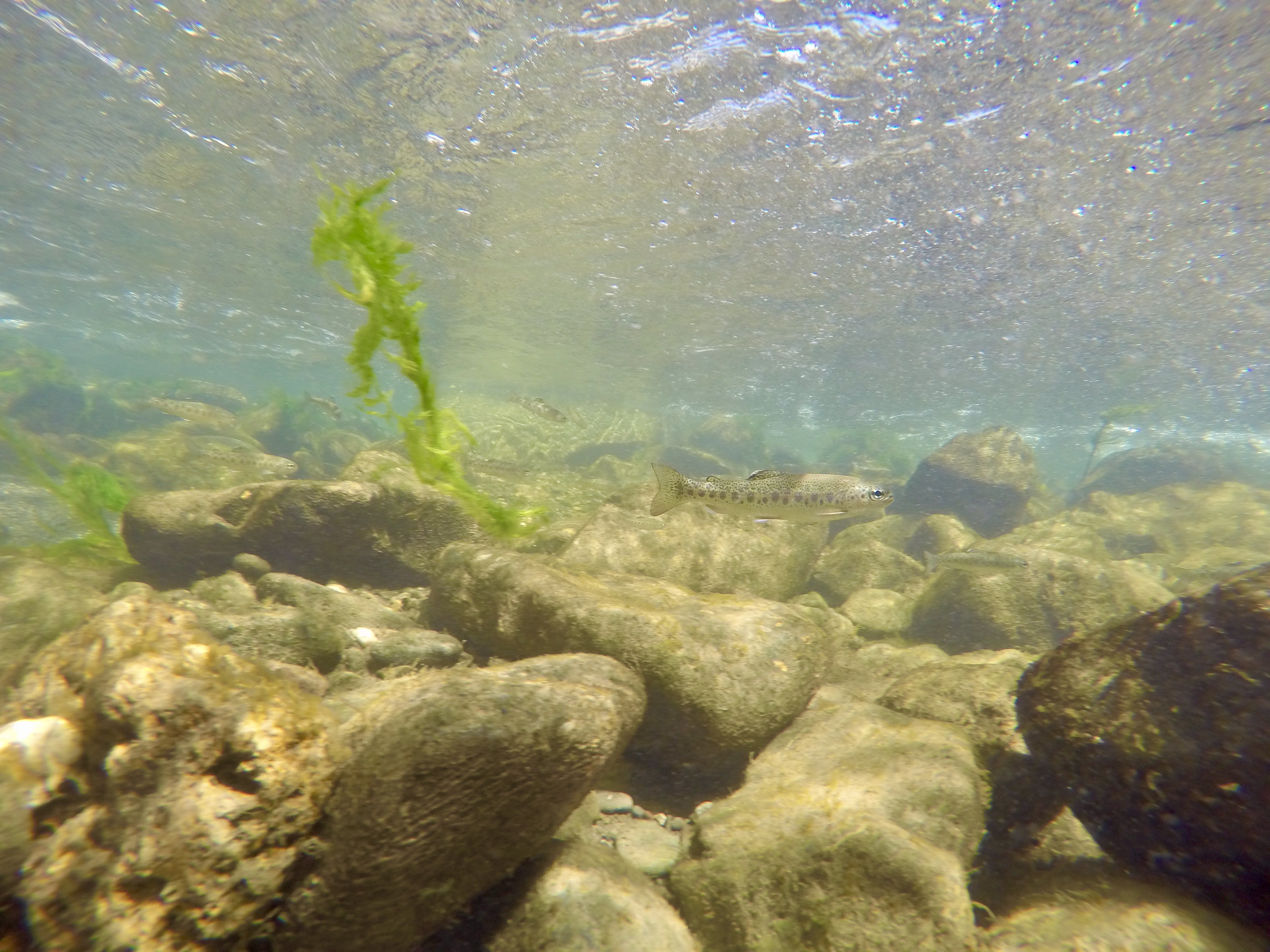
A juvenile O.Mykiss swims in the Pistol River.
Pistol River is a gem in and of itself, no hatchery releases, no barriers, an all natural stream supporting a wild run of fish. Heavy logging use and harvest of wild fish in the basin worries me and other stewards in the area for the future of Pistol River. For the past couple of years, ODFW restricted the harvest of Fall Chinook Salmon due to low forecasted runs.
Mark and I traveled down the coastal highway to the community of Brookings, Oregon. Our plan was to venture up the Chetco River to see access points, habitat, and allow me to physically see the area I have discussed in recent months. The watershed is characterized by large gravel bars down low and unparalleled habitat up high. In recent years, the Chetco Bar fire devastated key areas once home to large old growth forest, a detriment to the habitat. ODFW currently releases 50,000 hatchery winter steelhead smolts, and 200,000 Fall Chinook smolts each year for angler opportunity. Like stated above, these fish are hatched and reared at the Elk River hatchery and released mid way up the Chetco River.
According to ODFW, hatchery fish do not move past Nook Bar. This location is a public boat launch and recreation area utilized by many during the summer months. ODFW does not complete pHOS or adult surveys in the upper reaches of the Chetco River or in the upper reaches of the South Fork of the Chetco River.
This watershed showed unlimited potential for wild fish to thrive. It is my understanding that during the winter runs, the Chetco attracts fishermen from the entire region. It is not uncommon to see upwards of 50 boat trailers at public boat ramps.
I thanked Mark for the gracious tour, and traveled south to head home in Douglas County. On the way I crossed the Winchuck River and proceeded into California to the Smith River Basin. Here, I traveled north up and over into the Rogue Basin and Grants Pass.
The south coast hosts many watersheds with abundant wild populations of fish. At this point we are unaware of how many or what historical numbers of fish looked like, but we do know is that currently wild fish are more robust here than other coastal areas. Native Fish Society is advocating for the Oregon Department of Fish and Wildlife to increase their monitoring of these populations. The South Coast is the only area in the lower-48 states where recreational anglers can harvest a wild Winter Steelhead, yet we do not know how many adult fish return to spawn, leaving an important question: How much of our adult population are we harvesting for consumption?
During the current Rogue South Coast Planning process, Native Fish Society is asking for fisheries managers to limit harvest until current monitoring is in place. Until then we default to catch and release for wild Winter Steelhead - if we don’t know, let them go!
With the beautiful landscape and challenges the South Coast faces, it encourages me as the Southern Oregon Regional Coordinator to support our gracious local advocates, the River Stewards in these watersheds to help push our mission forward and return these fisheries to historic numbers. This robust ecosystem needs our attention, to help conserve and protect these free-flowing streams. As a community we must work together to share our ultimate vision with all; abundant wild fish, free-flowing rivers, and thriving local communities.
If you have any interest or questions about the current issues or areas of concerns on the South Coast or southern Oregon, please contact our Southern Oregon Regional Coordinator Kirk Blaine today. kirk@nativefishsociety.org
